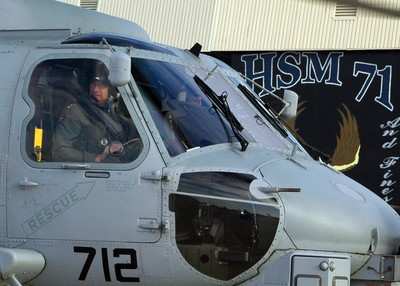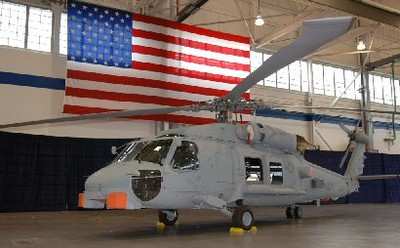Takes Flight In Navy's Newest Combat Helo, The MH-60R
The Navy's "Air Boss" experienced firsthand the future of naval
helicopter technology, and led roundtable discussions with the
senior rotary wing leadership stationed at Naval Air Station North
Island (NASNI) in December.

Commander, Naval Air Forces, Vice Adm. Thomas Kilcline, flew an
MH-60R Seahawk -- the Navy's newest combat helicopter -- with the
"Raptors" of Helicopter Maritime Strike Squadron (HSM) 71 to gain a
better understanding and appreciation of the airframe's operational
capabilities.
Kilcline and Lt. Carey Castelein, HSM-71 helicopter aircraft
commander, flew over Southern California. They simulated
anti-submarine operations, made approach landings and pushed the
airframe to its potential.
"The whole aircrew had a great time," said Castelein. "We got to
show the Air Boss exactly what we do as combat helicopter pilots,
while flying the finest, most capable airframe the Navy has to
offer -- it was an absolute pleasure."
Developed by Sikorski, the MH-60R was first introduced to the
Navy on January 23, 2006, as a training platform with NASNI's Fleet
Replacement Squadron, the Seahawks of Helicopter Maritime Strike
Squadron (HSM) 41. The Romeo made its first fully operational
debut, October 4, when the Raptors stood up as the Navy's first
combat-ready squadron comprised solely of MH-60Rs.
Before the MH-60R's development, the Navy employed the SH-60B
and SH-60F as the primary means to accomplish the anti-submarine
warfare and surface warfare helicopter missions.
The MH-60R features the best of both the SH-60B and SH-60F to
include added electronic support measures, airborne low frequency
sonar (ALFS), a multi-mission radar upgrade, forward looking
infrared (FLIR) and a weapons suite that includes torpedoes and
Hellfire missiles.
"The Romeo does a lot for anti-submarine warfare," said Cmdr.
Michael Nortier, commanding officer, HSM-71. "It brings the
capabilities that were in a couple of different airframes into
one."

In all, the MH-60R and its brother, the MH-60S Knighthawk, will
eventually replace the SH-60B, SH-60F and HH-60H helicopters
currently employed by the Navy.
According to Kilcline, this initiative complements the Naval
Aviation Enterprise's standing commitment to "deliver the right
force with the right readiness at the right cost at the right time
... now and in the future."
Following Kilcline's Romeo flight, the Air Boss met separately
with NASNI's rotary wing senior enlisted advisors followed by a
sit-down with senior officers to discuss hot topics affecting their
community.
One key issue was the shift from standard helicopter detachment
deployments. Now, the entire HSM squadron will deploy together as
part of the carrier air wing, as the Helicopter Anti-Submarine
squadrons do. However, the HSM squadron will be broken into roughly
four-airframe/20-person detachments and these detachments will then
be assigned to each ship in the carrier strike group.

This new concept provides more streamlined communication and
guarantees greater consistency in training qualifications among all
the helicopter assets in a single strike group.
These discussions with the West Coast's helicopter aviation
leaders and the Romeo flight fall in line with Kilcline's efforts
to meet face-to-face with every branch of naval aviation.
Kilcline took command of Naval Air Forces, June 22, and heads a
force that includes 11 aircraft carriers, 17 air wings, more than
3,500 aircraft, 169 active-duty and reserve squadrons and 100,000
plus personnel.
(Aero-News salutes Mass Communication Specialist 2nd Class
(SW/AW) Chris Fahey, Naval Air Forces Public Affairs)
 ANN's Daily Aero-Term (04.24.24): Runway Lead-in Light System
ANN's Daily Aero-Term (04.24.24): Runway Lead-in Light System ANN's Daily Aero-Linx (04.24.24)
ANN's Daily Aero-Linx (04.24.24) Aero-FAQ: Dave Juwel's Aviation Marketing Stories -- ITBOA BNITBOB
Aero-FAQ: Dave Juwel's Aviation Marketing Stories -- ITBOA BNITBOB Classic Aero-TV: Best Seat in The House -- 'Inside' The AeroShell Aerobatic Team
Classic Aero-TV: Best Seat in The House -- 'Inside' The AeroShell Aerobatic Team Airborne Affordable Flyers 04.18.24: CarbonCub UL, Fisher, Affordable Flyer Expo
Airborne Affordable Flyers 04.18.24: CarbonCub UL, Fisher, Affordable Flyer Expo





